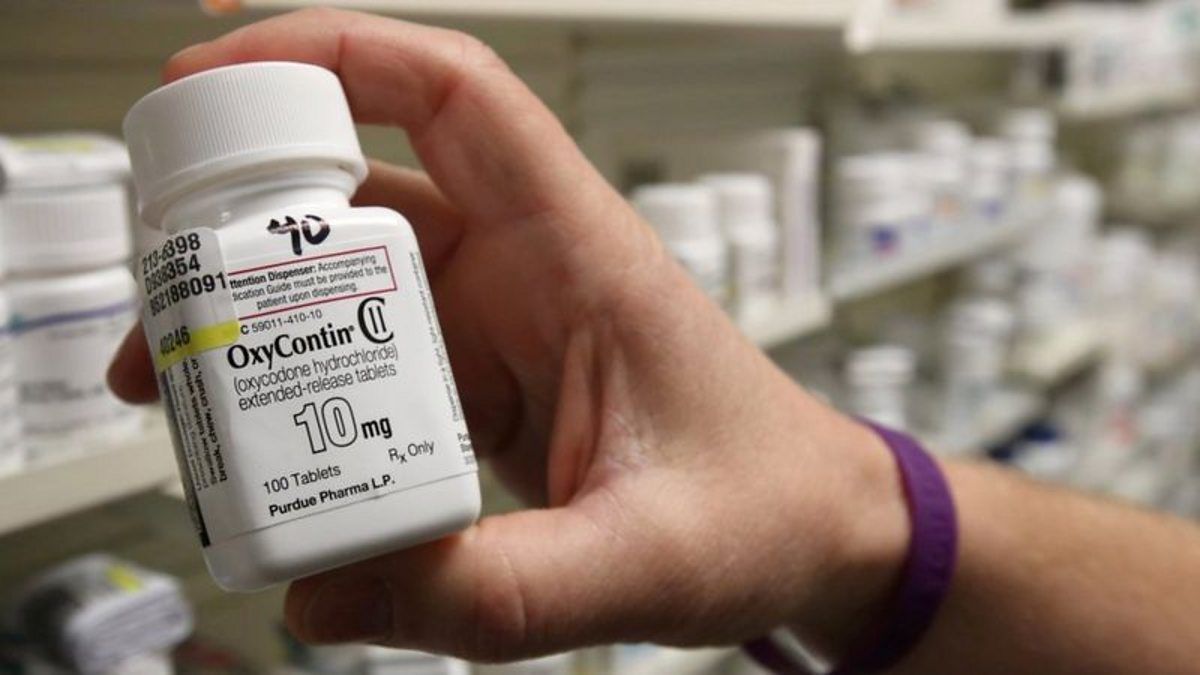The COVID-19 pandemic has worsened the opioid crisis in America

A few minutes every morning is all you need.
Stay up to date on the world's Headlines and Human Stories. It's fun, it's factual, it's fluff-free.
With vaccinations being administered and COVID-19 cases and deaths declining, the Biden administration may soon be able to refocus attention on the ongoing opioid crisis.
While most of the nation and its medical experts were understandably focused on the COVID-19 pandemic, an opioid crisis that has ravaged the United States for decades quietly grew worse. Even before the pandemic, the US led the world in the number of opioid-related overdose deaths, but such deaths spiked in early 2020 as much of the country went into lockdown.
Figures in both major US political parties have called the opioid crisis a top priority, with former President Donald Trump and current President Joe Biden each vowing in their campaigns to tackle it. During his time in office, Trump formed a commission to address the crisis, but the pandemic took precedent last year.
With vaccinations being administered and COVID-19 cases and deaths declining, the Biden administration may soon be able to refocus attention on the ongoing opioid crisis. Biden has already taken one concrete step by staffing up the Office on National Drug Control Policy with experts. But combating the opioid crisis will require substantial actions, especially after it worsened in 2020.
The worsening opioid crisis of 2020
Last month, a report by STAT, a Boston, Massachusetts-based health-oriented news website, published a startling statistic: from June 2019 to June 2020, 81,003 people died from drug overdoses in the US. It was the highest number of such deaths ever recorded over a yearly period in the country.
The most recent data from the Centers for Disease Control and Prevention (CDC) shows that drug overdose deaths took a sharp upturn in March, just as the pandemic took hold in the US.
The reasons for the increase were directly tied to the COVID-19 pandemic, Usha Lee McFarling explained in the STAT report: “The pandemic has ushered in stress, isolation, and economic upheaval — all known triggers for addiction and relapse — while robbing many people of treatment options and support systems.”
For addicts struggling to overcome their addiction or avoid relapses, their support network was dramatically reduced. Group meetings for addiction recovery were either canceled or limited in capacity and even when help was available, fear of the coronavirus kept many people home.
Earlier this month, Bloomberg’s editorial board argued that the worsening crisis must be addressed at the federal and state level, as well as through retraining law enforcement and medical personnel. It will require a collective effort, with Biden and Congress working with the states to create a unified path forward.
Addressing the crisis
From 1999 to 2017, the CDC determined more than 700,000 people had died from drug overdoses, including 70,000 deaths in 2017 alone. Before the pandemic, actions were being taken to address the opioid crisis.
In January 2020, top executives of Insys Therapeutics, a leading US pharmaceutical company, were sentenced to prison after being convicted of racketeering. The executives, who included Chief Executive Officer John Kapper, were found guilty of paying doctors to promote their drugs.
The arrests and convictions of the Insys executives were part of a broader effort to hold pharmaceutical companies responsible for their part in creating and worsening the opioid crisis.
A 2017 New Yorker report on the multibillionaire Sackler family and its company, Purdue Pharmaceuticals, helped ignite outrage over how such companies had lied about the addictiveness of their products.
In November 2020, Purdue Pharma, the creators of OxyContin, pleaded guilty to charges brought by the federal government. The company will pay US$8 billion and be dissolved.
While holding pharmaceutical companies responsible for their complicity in the crisis may help stem the problem, addressing addiction issues will require a broader effort.
Some states are looking at decriminalizing hard drugs as a way of doing just that. The somewhat counterintuitive idea is based on the theory that providing treatment is more helpful, both for the individual and society, than arresting drug addicts.
It’s a theory that has already been tested in Portugal where addiction rates and opioid overdoses dropped after the country decriminalized the use and possession of hard drugs in 2001. The policy also led to a decline in drug-related diseases, including HIV and hepatitis C.
Though decriminalization has its supporters in some states, it will be a tough sell on a federal level. Since the 1970s, the US government has been engaged in the so-called “War on Drugs" – a wide scale anti-drug policy agenda that has been supported by both parties and has cost over US$1 trillion.
Reversing course on such an entrenched government policy will be difficult, though there are many critics who argue its aggressive tactics, including mass incarcerations, have been a failure. They point to the ongoing opioid crisis as evidence that the five-decade “War on Drugs” has accomplished little in terms of real results.
The Commission on Combating Drug Addiction and the Opioid Crisis
During his 2016 campaign, then-candidate Trump repeatedly spoke about the need to address the opioid crisis. It didn’t take long for him to act once in office. In March 2017, President Trump signed an executive order to establish the Commission on Combating Drug Addiction and the Opioid Crisis.
The commission consisted of three state governors, as well as former US Representative Patrick Kennedy, then-Florida Attorney General Pam Bondi and Dr. Bertha Madras, a professor of psychobiology in the Department of Psychiatry and the chair of the Division of Neurochemistry at Harvard Medical School.
In November 2017, after meeting five times, the commission released their final report, which included 56 recommended actions to address the opioid crisis. The recommendations were broken down into categories: 1. Federal Funding and Programs 2. Opioid Addiction Prevention 3. Opioid Addiction Treatment 4. Overdose Reversal, and Recovery and 5. Research and Development.
The Opioid Addiction Prevention category included three subcategories: 1. Prescribing Guidelines, Regulations, Education, 2. Prescription Drug Monitoring Program (PDMP) Enhancements and 3. Supply Reduction and Enforcement Strategies.
The 138-page report states, “One of the most important recommendations in this final report is getting federal funding support more quickly and effectively to state governments, who are on the front lines of fighting this addiction battle every day.”
In its conclusion, the report states, “By the very nature of our federal-state-local governance, most solutions require responses at all levels of government. Some need the cooperation and the support of private institutions, such as commercial insurers, companies engaged in data analytics, academic institutions, or individuals who have inadvertently contributed to this crisis.”
The commission disbanded after publishing its final report. There’s little indication that Trump actively pursued any of the commission’s recommendations and his response to the crisis while in office received mixed reviews. From November 2017, reported drug overdoses in the US mostly plateaued, until they surged in 2020.
President Joe Biden’s campaign promise
While the opioid crisis didn’t get much coverage during the 2020 presidential election, both candidates spoke about the need to address the issue. On his 2020 campaign website, then-candidate Biden laid out his plan to end the opioid crisis. The plan includes five points:
• Hold accountable big pharmaceutical companies, executives, and others responsible for their role in triggering the opioid crisis.
• Make effective prevention, treatment, and recovery services available to all, including through a $125 billion federal investment.
• Stop overprescribing while improving access to effective and needed pain management.
• Reform the criminal justice system so that no one is incarcerated for drug use alone.
• Stem the flow of illicit drugs, like fentanyl and heroin, into the United States – especially from China and Mexico.
While the Biden administration has been focused on tackling the pandemic by passing a stimulus package and ramping up vaccinations, it has already taken some actions to address the opioid crisis.
Biden is staffing up the Office on National Drug Control Policy (ONDCP), though he is still searching for the agency’s director, a cabinet-level position which is often referred to as the “Drug Czar” (a term Biden coined in 1982). Biden has picked Regina LaBelle, a former member of the Obama administration, to be the deputy director of the agency for the time being.
It’s only a first step, but it does represent a reversal from the Trump administration, which had cut the budget of the ONDCP.
Biden has also received praise from some quarters for refocusing the agency’s priorities to include harm reduction and the racial inequality in drug policy. These actions are viewed as active antidotes to the “War on Drugs,” which Biden has been blamed for worsening, specifically through the 1994 crime bill he shepherded into law when he was a senator.The crime bill is often blamed for leading to mass incarceration in the US, particularly among people of color.
Have a tip or story? Get in touch with our reporters at tips@themilsource.com




Comments ()